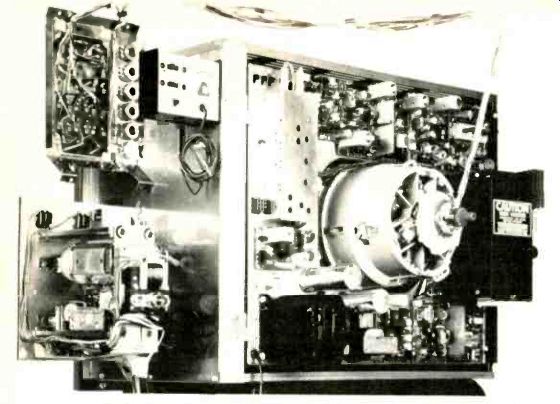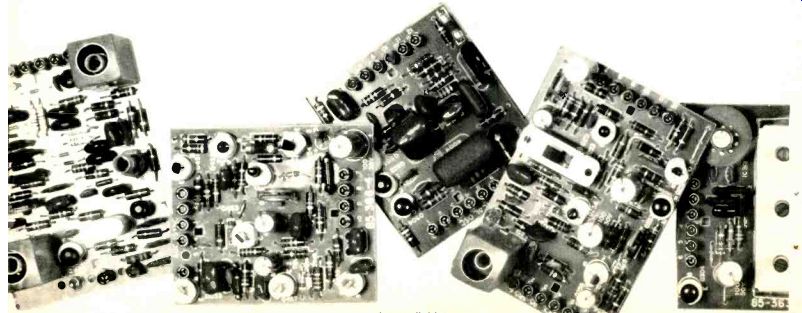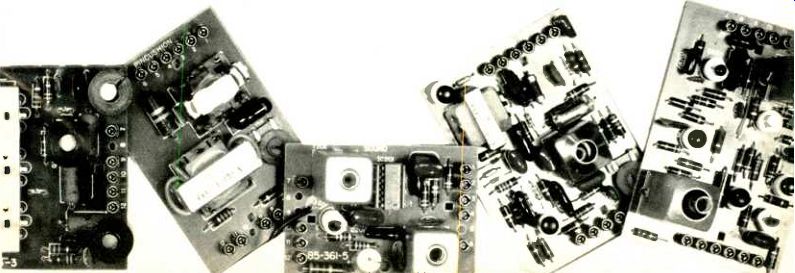By WILLIAM STOCKLIN /Editor

----- Rear view of assembly. There are actually two chassis available
(the only difference being picture-tube size); one has 227 square
inches (20-in diag.) viewing area, other 295 square inches (23-in diag.)
viewing area. Both are solid-state, using total of 45 transistors, 55 diodes,
four IC's, two SCR's, and two tubes (the picture tube and a high-voltage
rectifier tube).
Heath's new line of solid-state color-TV sets have many unusual features. Modular design simplifies construction and final test procedures; helps assure top performance.
ITS been several years now since the Heath Co. first contemplated developing a color-TV kit. Our first reaction at that time, considering the price they had projected, was that it would be a foolish venture. There wasn't any price differential then and there really isn't any today between the color kits they sell and what one can pay for an already-assembled receiver. Obviously there are other reasons besides saving money that make a person want to build a product of this type, since the sales of these kits have far exceeded the company's own expectations.
There are many individuals who just enjoy building something themselves. It is therapeutic in that it takes one's mind off other problems. And there certainly is personal satisfaction in having the set work upon completion. (Of course, it could be very frustrating too, should the set not work.) There are other good reasons; building any kit is educational if you really want to make an effort to study the product and circuit analysis that accompanies any kit. We would think that every electronics technician either taking a correspondence course or going to school, or even an electrical engineer going for a degree, would want to build a color-TV set to learn analog circuitry and also build a digital counter of some kind to learn digital techniques. Just to build a kit in itself and learn the techniques of wiring, soldering, and assembling various electronic components is something that any student should try in order to find out if it is what he likes. It's also a good way to get practical experience.
Still another good reason that should not be overlooked is that after completion one should be able to service and maintain the set with a minimum of effort, thereby eliminating expensive servicing costs. The plug-in, modular design used in the newest color-TV kit simplifies major service problems in that individual sections can be readily isolated. Any board can be easily removed and any module will be repaired at any one of Heath's 21 different service centers, after the 90-day free warranty period, at a cost of only $5 per panel. The centers will work on a 48-hr turn-around cycle.
We built the CR-370 kit and although it took us some 29 hours we enjoyed every moment. We ended up with several unsoldered connections, a soldering short on the a.g.c. board, and an improperly mounted transistor, but we had no difficulty in isolating these problems. The troubleshooting guide supplied with the kit is almost foolproof. Correct resistance and voltage measurements are given for almost every connection including all transistor terminals. After final alignment, the set worked as was expected; it compared favorably with the best color sets we have seen.
Design Details
Such features as automatic fine tuning (a.f.t.); solid-state v.h.f. tuner with MOSFET for greater sensitivity; solid-state u.h.f. tuner using hot-carrier diode; R-Y, B-Y color demodulators; adjustable video peaking; SCR sweep circuits; and many other features are incorporated. They follow much the same pattern as many of the color sets in the industry. What makes the Heath sets different arc the unusual features built into them.
There are two new color-set chassis available, the CR-270 and the CR-370. The only difference between them is the size of the picture tube which is either a 20-in or 23-in type.
Both are solid-state. We understand by the time this copy gets into print Heath will also have two additional models in this series. Basically the circuits are similar, the only major difference being that one will be a portable set using one of the new 14-in picture tubes. The other will be a 25-in picture-tube version using the new square tube.
One of the greatest features-and it is sort of a trademark for the company-is that these color sets include a built-in dot generator and gun-shorting switches. These are used not only in the final convergence of the assembled kit but also as a self-servicing aid; you can perform convergence and color purity adjustments on these color-TV sets periodically if required. A very inexpensive volt-ohm-meter is also included in the kit for checking resistance and voltage. There is no need for any other test equipment. For those who are familiar with alignment techniques and have the necessary equipment, the company includes complete alignment procedures in one of the booklets accompanying the kit.
A rather unusual feature is that the sets include power tuning. You can scan through all v.h.f. and one preselected u.h.f. channel at the push of a button. An automatic motor-driven tuner advances one channel at a time. This ties in nicely with their remote-control unit, should you care for this added feature. The remote control consists of a transmitter that sends out an ultrasonic signal, a microphone that picks it up, and a receiver that produces the correct function in the set. There are 9 functions that can be controlled this way--TV on; TV off; reduced volume; further reduced volume; v.h.f. channel selector; tint clockwise and counterclockwise; color clockwise and counterclockwise.
It's getting to be relatively common practice to provide antenna inputs for both 300-and 75-ohm antennas on hi-fi equipment but the trend has not extended to the TV industry as yet. These Heath sets, though, do have provision for 300-ohm balanced or 75-ohm coaxial lead-ins for v.h.f. and a 300-ohm balanced input for u.h.f. One of the instruction manuals accompanying the set includes a comprehensive section on antenna problems. Complete details are given on how to build your own attenuator pads if you are in too strong a signal area and the proper use of preamplifiers if you are in a fringe area.
To some, a rather important feature is the fact that the a.c. power input is adjustable for low or high line voltages.
You have a choice of connecting the set for use with either 120 or 130 volts, 60-hz a.c. sources. This is important for those living in areas where the line voltage is high.
In addition to the conventional picture-tube degaussing coil, the sets also have provision for connecting an external coil (which is supplied) that can be used periodically to degauss the various elements. This is most important after completion of the set and even later should such devices as vacuum cleaners get too close to the set.
"Instant-On," while not that fast, is a theme promoted by Heath. This certainly prolongs tube life and permits the set to come on a little faster. Heath has two "on /off' switches-one shuts the entire set off should it be used only on rare occasions; the other can be used to shut off all voltages other than to the picture-tube filament, thus providing the "Instant-On" operation.
IC's are no longer a novelty since they are appearing in all types of consumer products. The four used in these sets are in the sound section, chroma demodulator, the 3.58-MHz color oscillator, and the automatic fine-tuning control (a.f.t.). No doubt IC's will become increasingly popular in time, eventually being used throughout the entire set.
In covering what we believe are some of the most important, unusual features, we should mention the company's exclusive "Magna-Shield," which consists of metal panels that completely surround the picture tube on all sides and a metalized chassis in the rear (which, incidentally, is hinged and can be swung out for servicing). The shield prevents stray magnetic fields from distorting or affecting the television picture.
In addition to normal 4-or 8-ohm speaker outputs the set has a separate hi-fi output directly off the emitter-follower ahead of the audio-output stages. This provides a .3-volt r.m.s. signal across 1000 ohms with a response of 30-10,000 Hz ±1 dB. Harmonic distortion is quoted at less than 1% at 1000 Hz.
Plug-in, modular construction is, in our opinion, one of the greatest features of these sets. Much military as well as computer equipment uses this technique. The greatest problem that arises with this type of construction is contact failures between panel assemblies. In realizing this, Heath has done a remarkable job of assuring failure-proof operation with extremely sturdy contacts. Their philosophy of reliability extends beyond this; each component has a very generous safety factor. It was quite obvious that the quality of individual components was not affected by any cost-cutting attempt and we believe, from the viewpoint of reliability, that these television sets are superior to all other color-TV sets on the market.
(For more specific technical details on the company's complete line of color sets, see page 28.)


----- Design is based around ten separate plug-in modules (from left
to right): 3.58-MHz osc.; a.g.c. /sync; vertical osc.; luminance;
video output; pincushion; sound: horizontal osc.; chroma; and (not shown)
convergence circuit board. Additional circuit boards are used in the pre-assembled
and pre-aligned u.h.f. /v.h.f. tuners, the three-stage i.f. amplifier,
the high-voltage and automatic fine tuning (a.f.t.) assemblies